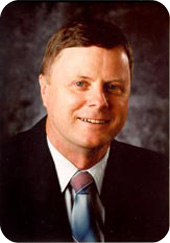 |
 |
WRQ Sponsor Mes,sage |
|
|
|

Duane
Zitzner
|
Parenting Many
Product Offspring
Duane Zitzner considers every product in his HP family
an apt solution. But asking him to focus HP’s attention on a
single child doesn’t fit the current corporate philosophy. This
executive elected a vice president of the company in 1996 reports
directly to CEO Carly Fiorina, and is in charge of product technology
and development for all of HP’s computer products and systems.
Zitzner also sits on the HP Executive Council. He is responsible for
HP’s computer products and systems, including commercial and
home PCs, HP NetServers, Unix servers, storage, and software products
such as OpenView. And yes, even the HP 3000. He receives a report
from the Business Critical Computing organization that contains HP
e3000, HP 9000 and business intelligence storage products. Zitzner also manages HP’s investments in computer
technology and ensures proper resource allocation for the entire
Computing Systems segment. He came to HP from IBM in 1989, joining as
a section manager in the Roseville Networks Division in California,
and was quickly promoted to R&D manager of the Network
Architecture Lab. In 1991, he was named general manager of a PC
division which became the Network Server Division in 1993. He was
named general manager of the Networked Systems Business Unit in 1994,
was promoted to general manager of the Personal Information Products
Group in 1996. Zitzner was named HP’s President of Computing Systems
last fall, part of a move that also gave Ann Livermore a presidential
post. Fiorina said that Zitzner is “one of our brightest and
most aggressive technologists,” and said is “responsible
for HP’s software stack. This includes software that
differentiates HP’s systems and multiplatform software
businesses.” Zitzner began his career as a programmer at Univac,
so his vantage point on the HP business can often be a technical one.
We put questions to him that some customers asked while MPE was
absent from the company’s communications outside the
platform’s customer base We wanted to know what the product
chief believes a mention of the 3000 to analysts and the general
market might do for HP, and what the platform’s prospects are
for becoming a multiplatform solution once again. Is the HP e3000’s operating environment as strategic to HP as Unix, NT or Linux? It’s strategic, is the way that I’d put it. I say that in the sense that what happened was that we were looking at Linux, HP-UX and NT, and we didn’t talk about very important and very strategic operating systems like MPE, like NetWare. There’s a whole bunch of them we didn’t talk about, and it got totally taken out of proportion to what it was. It got escalated and should never have gotten there. Lots of people got all wrapped around an axle and shouldn’t have had to do that. That’s as much our fault as anybody’s, but it
goes back to snippets and trying to put them together. My answer to that is that it’s based on customers. Customer needs and customer wants drive what we do, in every way, shape and form inside of HP. If we have customers that want certain technologies, we’re going to be working on those technologies. And we are today in the area of the 3000. We’ve got a lot of work going on in that space, and it will continue as we move forward. Everything comes back to our customer. And let us not forget: You’ve got the Unix wars, and that’s between Solaris, HP-UX and AIX. The other guys, like True64, are having difficulties. You have lots of stuff going on in the marketplace with datacenter and Microsoft NT, and Linux is the new upstart that’s in this space. All the press, your peers in the industry, that’s what they’re writing about. This morning when I gave my talk, I talked about the imperatives that we in HP have to drive on. One of them was reliability, and I said “Let me show you the example of what is the ultimate in reliability. It’s an MPE 3000 machine.” The machine has been around for three decades, and you
know, you get it right for sure if you’re there. This has been driven by the customers. It’s all
customer-based. It
still is based on if you’re a customer and you’re buying
product, I’ve got to be able to solve your problem — to
help you, with me, solve that problem. Based on the needs you’ve
got and the tool bag I’ve got we’ll decide how we’re
going to solve your problem. Everything’s driven by
applications. We focus too much on the OS and the hardware, but the
reality is that it’s above that. It’s the solution. That’s a fair way of saying it. We’re using the
same physical hardware now on the 3000, and we’ve moved the 3000
into the whole e-world. There’s a whole bunch of things. You say
it’s a niche, okay, but given where it’s at, the stuff that
we’re doing is an attempt to make it as successful as it
possibly can be. I
know. But HP-UX is our own system too. Linux is open source, and in
the case of NT, that comes from Microsoft. It’s all driven by business and customers. We’ve
got to have that in order to stay in business. If I can’t sell
the products, I can’t generate the revenue and the margin to pay
the salaries to keep the business running the way we want it to go.
It’s your chicken and egg problem all over again. I
would love to, if you’ve got the crystal ball to tell me how to
do it. You’re making the assumption that HP doesn’t
want to break it. The reality is that it’s driven by the
solutions guys. Sometimes you can’t even throw money at people
to have them do it. Then you have to say, “Where does this
product really peak? Where is it really good, for what things?”
Then if you get something that will really fly, you will attract the
appropriate solutions guys — because it excels. And the customer
doesn’t care what’s underneath, typically. I
agree. The product can do just fine for those who have a certain
sense of “this is what I want to go do.” You said it’s
a niche; I don’t know if it is or not. It’s definitely a
certain segment of the market that the product appeals to. We need to
make sure that we have the continued focus on the stuff where it is
good. Yeah, it will come back to that. I would say that the
focused solution is probably where it’s going to be. But again,
the better person to ask that of is [division GM] Winston Prather. What do you mean it doesn’t appear on HP’s radar
screen? Because it’s on mine. Well, I’ll change that statement. Reality wise, when we put together this multi-OS strategy — and I’ve been working on this a long time — it’s based on customers and what I’m hearing as I’m talking to people. What I’m seeing going on in the market place, where are the ISVs working. We’ve got to make sure we’re peaked up in those spaces. I went through that process, and I was so focused in those areas, it was like what happened this morning. One guy said, “Your speech would have been perfect, if you’d have talked more about services and solutions than you did.” That was a little bit like what happened with that communique. I put together, based on what we thought were the things that — it was an oversight. Netware wasn’t mentioned, and that’s something like 25 percent of our NetServer business, which is huge. If you look at it, there’s a whole bunch of things that didn’t appear on there because of the process we ran. I have been active in publishing what we’re doing to our employees, because I want people to know where it’s heading. If there’s something missing, tell us. Well, we heard. And we said, “Oh, that was a mistake.” Is it HP’s place to create demand for a computing
solution that it has invented? Are you still in the demand creation
business? I’m not, because I’m the product guy. I build products. We’re doing a very different kind of demand creation inside of HP today. The way we’re going about the product stuff, we’re really trying to have a more unified approach. In the past, we would have had the silo mentality. We’re going to inundate the market with everything we do and flood the market. If you look at our TV ads, very much we’re on the brand. In our print ads, there’s lots of products you don’t see like you used to see. All the money used to be at the product level, and now it’s not. That’s a choice point we made as a corporation. We
were fragmenting the brand. What happened what that it wasn’t
Hewlett-Packard that was important, it was 3000. Or 9000, or
NetServer or Vectra. And that’s not a brand. Hewlett-Packard is
the brand. This is a downside. I don’t know how much difference it can make. I can’t quantify that. Let me tell you, this is a problem when you have all these products. And I’ve got a lot of them, and for me to talk about all of them — and by the way the same can be said about lots more things, like our networking business — I can talk about PC business but I may not talk about notebooks. Servers versus consumer. It’s very difficult to deal with the spread of what we’ve got, because we’re a very big company. Does it make a difference? I think it does. But the reality is that you can’t talk about everything all the time. It’s not like children. You don’t just have however many you might have. You have a bunch, and we have a lot of them. It’s very difficult to talk about all these different things. After a while you get so fragmented. What I’m attempting to do is hit on as many of the different areas as I could. I used Pavilion in an example of the speed of our life cycles. I never talked about networking, and I think I talked about ChangeEngine. But I will guarantee you somebody will ask me why I didn’t talk about something. Too much of this and it becomes a blur, it doesn’t become meaningful anymore.
|
Copyright The 3000 NewsWire. All rights reserved.
